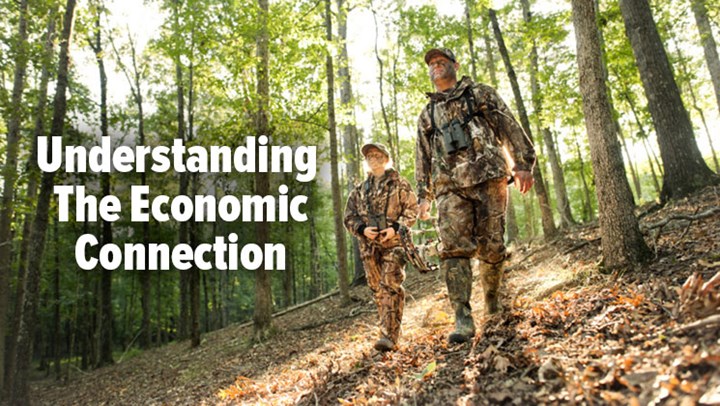
by Chris Chaffin - Sunday, August 19, 2018

Following the National R3 (Recruit/Retain/Reactivate) Symposium in May, three of the major partners in the R3 campaign released a new report on the project revealing trends that are important to the future of hunting and fishing. [Author’s note: Don’t forget the close association between hunters, anglers and conservation funding when fisherman data is included in this article.] Specifically, the Council to Advance Hunting and the Shooting Sports (CAHSS), the Recreational Boating and Fishing Foundation (RBFF) and the American Sportfishing Association (ASA), released findings from a project conducted 2017 by Dr. Loren Chase of Chase and Chase Consulting that analyzed hunting and fishing license data from 26 different state fish and wildlife agencies, or 56.3 percent of paid license holders in the nation.
Titled “The Future of Hunting and Fishing Project,” the report expands on work done previously by Dr. Chase. The months-long project was designed to examine “…shifts in demographics of cohorts of hunters and anglers through time, and to determine the impact of different factors (age, period or cohort) on overall license sales.” The study was built on the foundation of findings from 1992 to 2012 collected from just a few states. This most recent phase examined license sales trends from 2012 to 2017.
Project managers wanted to better understand the declines and shifts in hunting and fishing license sales, and the resulting impact on the future trajectories of conservation revenues. Findings clearly show there is an immediacy to the financial challenges facing the overall conservation community brought about by changing hunter and angler participation. It predicts that “reductions in agency funding could occur as soon as 2024, due to a generation of hunters and anglers aging out of participation.” Significantly, the study reports that by 2032—only 14 years from now—wildlife agencies and other conservation organizations may face great challenges in revenue shortages, loss of political capital and shrinking social relevancy.
Data from the study also shows that participation in hunting and angling is not dictated by the age of a person nor a specific period in time, but rather by the generation to which a person belongs. Project leaders report that the results of this project offer new perspectives on participation that can help state fish and wildlife agencies understand their participation rates and work this knowledge into future recruitment, retention and reactivation (R3) strategies.
Participation increases with youth (defined as ages 12-17) but declines during college years and as individuals move through adult establishment years (defined as ages 18-27.) Participation increases again once adults have established disposable income and have jobs that allow time for recreation. As they reach their 70s, physicality often precludes participation.
According to CAHSS CEO John Frampton, “‘The Future of Hunting and Fishing Project’ offers a different view of buying habits of hunters and anglers in the United States. With this data, we can understand the future implications of an aging population of hunters, and better understand the factors that influence license buying rates. Agencies can now use this information to refine their R3 strategies to ensure a continued customer base and long-term funding for their agencies.”
Based on what was learned from the study, below are examples of what state fish and wildlife agencies, and other partners, can do to address the expected license-sale shifts. These findings are important as R3 professionals and other sportsmen work with agencies and organizations to reverse downward participation trends.
1. Adopt a customer-centric approach in which R3 professionals focus on trends in purchasing habits and customer demographics. This ensures the opportunity to fully understand customers and their needs and develop a strategic approach to engage them in hunting and angling.
2. Understand the current trends and shifts in license buying trends to craft more strategic R3 efforts. Recruiting, retaining and reactivating new audiences such as women, young adults, families and culturally-diverse audiences will be vital to increasing license sales and sustaining long-term participation in hunting and angling.
3. Seek partner and stakeholder buy-in when developing R3 strategies so plans will increase hunting and fishing participation.
4. Focus on shifting customer demographics so the manner in which hunting and fishing are promoted evolves.
5. Evolving trends in participation in hunting and fishing require R3 professionals to continue to evaluate current R3 efforts to measure outcomes and employ adaptive management techniques to continue to refine their R3 strategies.
Rebuilding the numbers and status of the American hunter is a long-term effort that requires commitment and hard work by sportsmen and other conservationists, the hunting and shooting industry and new insights and approaches such as those identified in the new report.
For more information on “The Future of Hunting and Fishing Project,” click here.
■ ■ ■
About the Author
Chris Chaffin has been an outdoor communicator, educator and partnership manager for more than 40 years. He has worked on the national scene representing several prominent components of the outdoor community promoting hunting, fishing, the shooting sports and conservation. He served two terms as Treasurer for the Professional Outdoor Media Association (POMA), eventually taking on roles as vice-president, President and Chairman of the Board.

In 2007, he launched Chaffin Communications, Inc., a communications consulting company focusing on the outdoors. In 2012, with support from the Outdoor Adventure Dream Giveaway, Chaffin founded and currently manages the Outdoor Adventure Conservation Fund, a Florida non-profit established to encourage and facilitate more people participating in traditional outdoor activities. For more information, click here.
E-mail your comments/questions about this site to:
[email protected]
